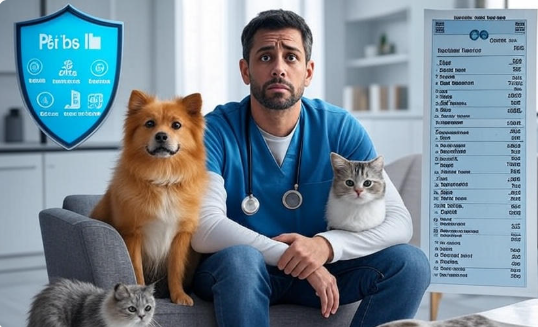In a world where pets are treated as cherished family members, ensuring their health and well-being has become a major priority for millions of households. As veterinary costs continue to rise and treatment options become more advanced—and expensive—pet owners are increasingly considering pet insurance as a means of financial protection.
But the question remains: Pet Insurance: Is It Worth It in 2025? This article offers an in-depth, practical analysis of whether pet insurance still delivers value, what has changed in 2025, and how you can make the smartest choice for your furry friend.
Table of Contents
ToggleUnderstanding Pet Insurance in 2025
What Is Pet Insurance?
Pet insurance is a reimbursement-based financial product that helps cover veterinary expenses resulting from accidents, illnesses, and sometimes even routine wellness care. Unlike human health insurance, pet insurance policies require owners to pay the vet directly, then submit a claim to receive reimbursement.
Types of Pet Insurance Plans
In 2025, the pet insurance market offers more variety and customization than ever before. There are three primary types of plans:
-
Accident-Only Coverage: Covers injuries caused by sudden incidents like vehicle accidents, falls, or lacerations.
-
Accident and Illness Coverage: The most common plan. Covers everything from broken bones to cancer, infections, and chronic diseases.
-
Wellness and Preventive Care Add-ons: Optional plans that help cover the cost of vaccinations, dental cleanings, flea control, and regular check-ups.
Some insurers now offer “comprehensive care” bundles that combine all three for a higher monthly premium.
Why Pet Insurance Has Gained Traction in 2025
Pet insurance has become more widely adopted in 2025 due to several driving forces:
1. Surging Veterinary Costs
Veterinary medical technology continues to improve, allowing pets to receive treatments once reserved for humans—MRIs, chemotherapy, organ transplants. But these advances come at a steep cost. A broken leg can cost over $3,000 to treat, while cancer treatment could top $10,000.
2. Increased Pet Lifespans
Improved nutrition and care mean pets live longer. While that’s great news, it also increases the likelihood that a pet will develop chronic conditions like arthritis, diabetes, or cancer—conditions that are expensive to manage over time.
3. Humanization of Pets
In 2025, pets are more than animals—they’re family. With that shift comes an emotional drive to do everything possible to protect them, including buying insurance to afford emergency care.
4. Better Product Options
Modern pet insurance providers offer more flexible policies, digital tools, fast claims processing, and 24/7 support. Some even integrate with vet software, allowing for near-instant reimbursements.
How Much Does Pet Insurance Cost in 2025?
Premiums have risen slightly over the past few years due to inflation and increased veterinary costs, but pet insurance still remains within reach for most owners.
Pet Type |
Average Monthly Premium (Accident & Illness) |
Average Monthly Premium (Accident-Only) |
|---|---|---|
Dog |
$62 – $85 |
$20 – $30 |
Cat |
$30 – $48 |
$15 – $25 |
Cost Variables
-
Age: Premiums increase as your pet gets older.
-
Breed: Purebred animals tend to cost more due to genetic predispositions.
-
Location: Urban pet owners may pay higher premiums due to costlier veterinary services.
-
Coverage Options: More comprehensive plans naturally come with higher costs.
-
Deductible & Reimbursement Rate: Choosing a lower deductible or a higher reimbursement percentage (e.g., 90%) increases your monthly premium.
What’s Typically Covered?
Every insurance provider is different, but most accident & illness policies will include:
-
Emergency room visits
-
Surgery and hospitalization
-
X-rays and diagnostic imaging
-
Prescription medications
-
Chronic conditions (e.g., diabetes, hypothyroidism)
-
Hereditary and congenital conditions (depending on the insurer)
-
Cancer treatments
-
Alternative therapies (acupuncture, physical rehab)
New Inclusions in 2025
Some modern policies are now covering behavioral therapy, breed-specific issues (like hip dysplasia in large dogs), and even mental health support for pets—something almost unheard of five years ago.
What Pet Insurance Doesn’t Cover
Despite broadening coverage, pet insurance still comes with exclusions:
-
Pre-existing conditions
-
Cosmetic or elective procedures
-
Breeding or pregnancy-related costs
-
Preventive care (unless you purchase a wellness rider)
-
Dental cleaning (unless medically necessary)
-
Experimental or non-approved treatments
Always read the policy carefully, especially the exclusions section. The fine print often determines whether or not a claim will be reimbursed.
Pros of Pet Insurance in 2025
1. Financial Protection
One serious emergency or chronic illness can set you back thousands of dollars. Insurance limits that risk and gives you access to advanced care without the fear of bankruptcy.
2. Improved Pet Outcomes
Owners with insurance are more likely to approve necessary surgeries or treatments without delay. That often leads to better health outcomes and longer lifespans.
3. Predictable Monthly Costs
Instead of being blindsided by a massive vet bill, you pay a predictable monthly premium.
4. Customizable Plans
With multiple levels of coverage, deductible choices, and add-ons, today’s policies can be tailored to fit a wide range of budgets.
Cons of Pet Insurance in 2025
1. Upfront Payments Required
You must still pay for treatment upfront and wait for reimbursement. This can be difficult for emergencies.
2. It May Not Be Cost-Effective for All Pets
If your pet rarely needs medical attention, you might end up paying more in premiums than you ever claim.
3. Claims Can Be Denied
If a condition is deemed pre-existing or unrelated to what the policy covers, you might be stuck with the full bill.
4. Premiums Increase Over Time
Your monthly cost will likely rise as your pet ages, especially after age 7 or 8.
Who Should Consider Pet Insurance?
While pet insurance can benefit many, it’s especially recommended for:
-
Puppies and Kittens: Enrolling young pets ensures full coverage for future illnesses without being blocked by pre-existing condition clauses.
-
High-Risk Breeds: Bulldogs, dachshunds, retrievers, and Persians—breeds prone to genetic disorders—often benefit greatly from insurance.
-
First-Time Pet Owners: If you’re not familiar with potential medical costs, insurance provides a safety net.
-
Pet Owners Without Emergency Savings: If an unexpected $5,000 vet bill would create financial strain, pet insurance is a smart investment.
When Pet Insurance Might Not Be Worth It
Pet insurance may not be the best choice if:
-
Your pet is already older or has several pre-existing conditions.
-
You are financially prepared for high out-of-pocket vet costs.
-
You prefer the idea of setting aside money monthly in a personal savings account.
It’s also worth considering that some pet parents feel more comfortable paying out of pocket for routine care and only want coverage for catastrophic events—which accident-only plans may address more cost-effectively.
Alternatives to Pet Insurance
Pet insurance isn’t the only way to prepare for your pet’s health expenses. In 2025, these alternatives have gained popularity:
1. Pet Health Savings Accounts (HSA)
Some banks and financial institutions now offer pet-specific HSAs with tax advantages. You set aside money each month to cover future costs.
2. Vet Wellness Plans
Some veterinary clinics offer in-house plans that cover annual exams, vaccines, flea prevention, and discounted services for a monthly fee.
3. Emergency Funds
Building a dedicated pet emergency fund—say, $1,000 to $5,000—can give you the flexibility to handle unplanned costs without insurance.
4. Charities and Nonprofits
Organizations like The Pet Fund, RedRover, and local humane societies offer financial aid for qualifying pet owners.
Case Examples
Case 1: Bailey, 2-Year-Old Labrador Retriever
Bailey tore a ligament while playing at the dog park. The total vet bill for diagnostics, surgery, and recovery was $4,700. Thanks to insurance, Bailey’s owner only paid $850 out of pocket.
Result: Pet insurance saved over $3,800.
Case 2: Felix, 9-Year-Old Domestic Shorthair
Felix developed chronic kidney disease. The treatment was only partially reimbursed, as insurance classified it as a pre-existing condition.
Result: Insurance coverage was limited; self-funding might have been more effective.
Case 3: Bella, Mixed-Breed Puppy
Bella’s owner opted for a high-deductible plan ($1,000/year) at a lower monthly rate. After a year with no major claims, the owner saved money but still had coverage for emergencies.
Result: Balanced coverage and affordability.
FAQs
Is pet insurance worth it in 2025?
Yes, for many pet owners, pet insurance is worth it in 2025, especially for younger pets, high-risk breeds, or owners without emergency savings. With rising vet costs, insurance provides essential financial security and peace of mind.
How do waiting periods work?
Most plans have waiting periods—usually 2–15 days for accidents and 14–30 days for illnesses—before coverage begins.
Will my premiums go up every year?
Typically, yes. Insurers adjust rates annually based on your pet’s age, medical history, and the rising cost of care.
What happens if I change insurance providers?
Switching may result in loss of coverage for pre-existing conditions. Always compare the impact before making a change.
Can I use any vet?
Yes, most policies allow you to use any licensed vet, specialist, or emergency clinic in your country.
Conclusion
So, Pet Insurance: Is It Worth It in 2025? The answer depends on your pet, your finances, and your comfort level with risk.
For many pet parents, especially those with young or high-risk animals, insurance can be a powerful tool for financial stability and peace of mind. It ensures that decisions about your pet’s care are based on need—not cost.
However, it’s not one-size-fits-all. You must consider your pet’s age, breed, medical history, and your financial buffer. Insurance won’t always be cheaper in the long run, but it does offer protection against the unpredictable.
Before signing up, shop around, compare providers, and read the fine print. Whether you go with a policy, a savings strategy, or a mix of both, planning ahead is always the best form of protection.












